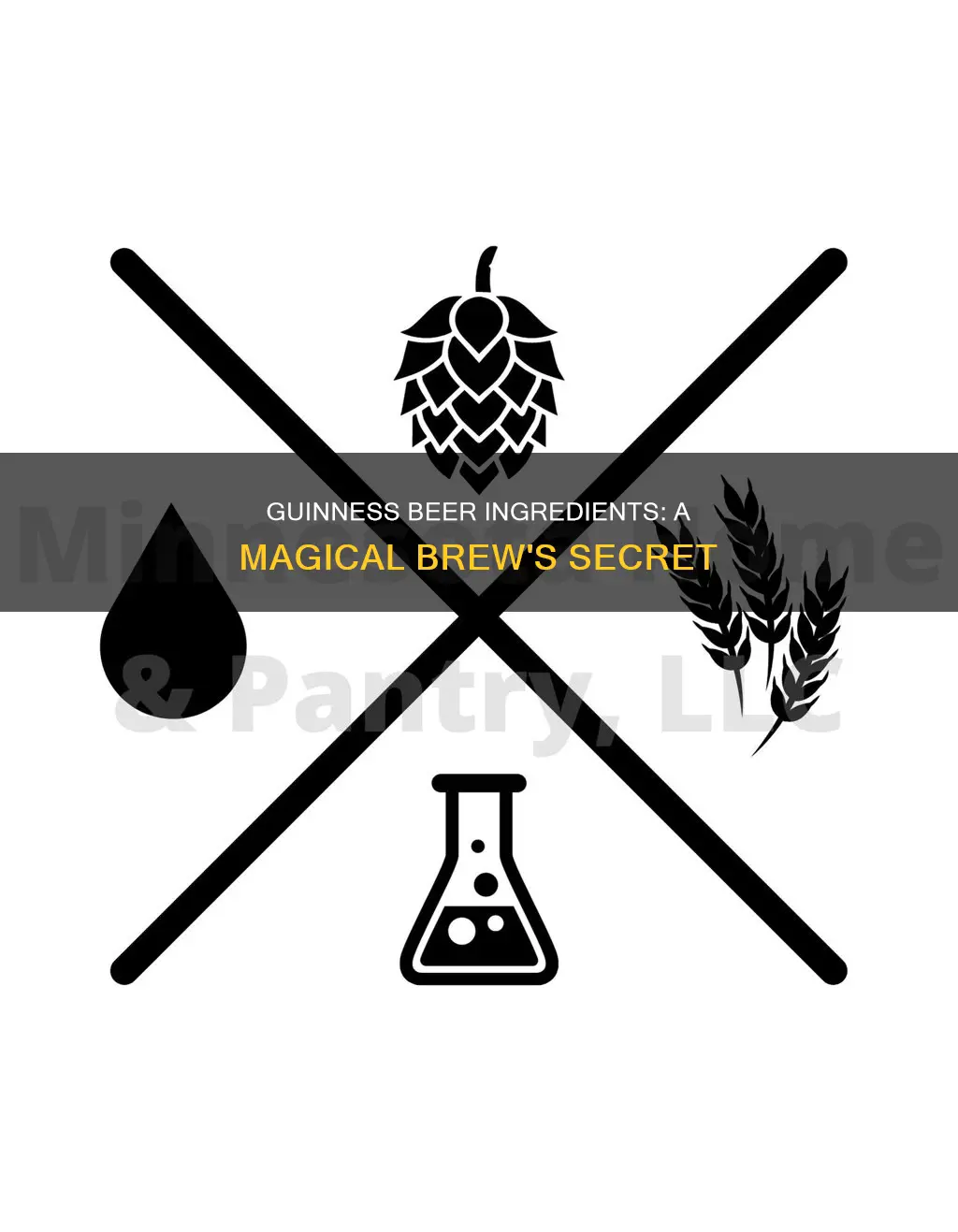
Guinness is a stout beer with a distinctively dark colour and creamy head. Its key ingredients are roasted barley, malted barley, hops, yeast and water. The roasted barley gives Guinness its dark colour and characteristic taste, while hops add bitterness to balance the sweetness of the malt. The beer's famous creamy head is the result of nitrogenation, a process where a mix of nitrogen and carbon dioxide is used instead of just carbon dioxide to create a smoother, velvety texture.
| Characteristics | Values |
|---|---|
| Ingredients | Water, barley (malted and roasted), hops, yeast |
| Flavour | Derived from malted barley and roasted unmalted barley |
| Colour | Dark shade of ruby |
| Alcohol Content | Varies depending on the product, ranging from 0% to 8% ABV |
| Calories | Approximately 210 calories per standard pint (568 ml or 20 oz) |
| Vegan-Friendly | Yes, since 2017 due to a new filtration process |
What You'll Learn
- Water: Sourced for its purity, water is essential to the brewing process
- Barley: A mix of raw, malted and roasted barley gives Guinness its colour and taste
- Hops: Hops balance the sweetness of the malt and preserve the beer
- Yeast: Yeast converts barley sugars into alcohol through fermentation
- Nitrogen: Nitrogen is added to Guinness to give it its creamy mouthfeel and head

Water: Sourced for its purity, water is essential to the brewing process
Water is an essential ingredient in Guinness beer, accounting for about 95% of its total ingredients. The type of water used in the brewing process is carefully selected to ensure its purity and can make the difference between a good beer and a great beer.
The water used in brewing Guinness is sourced for its purity and taste. It is chosen to complement the other ingredients and enhance the overall flavour profile of the beer. The water should be clean and free of any unpleasant odours, such as chlorine or pond smells, which could negatively impact the final product.
The mineral content of the water is also crucial. Water with the right balance of minerals can promote clarity, flavour, and stability in the finished beer. Calcium, for example, is important for increasing mash acidity, assisting with enzyme activity, and extracting hop bitterness. Magnesium contributes to enzyme activity and acts as a co-factor for yeast during fermentation.
The pH level of the water is another key factor. The ideal pH range for the mash in the brewing process is between 5.2 and 5.6, as this optimises the activity of the enzymes involved. During fermentation, a lower pH helps protect the beer against spoilage organisms.
Brewers may also adjust the water chemistry to fine-tune the flavour and balance of the beer. For instance, a higher ratio of sulphates to chlorides will emphasise the hop bitterness, resulting in a drier and crisper taste. On the other hand, a higher ratio of chlorides will make the beer seem fuller and sweeter, emphasising the malt character.
In summary, water plays a critical role in the brewing process of Guinness beer. Its purity, mineral content, and pH level all contribute to the overall quality and flavour of the beer. Brewers carefully select and treat the water to ensure it meets the specific requirements of their recipe, highlighting the importance of this often-overlooked ingredient.
Vegan Alert: Guinness Beer's Surprising Ingredient
You may want to see also

Barley: A mix of raw, malted and roasted barley gives Guinness its colour and taste
Guinness is a stout beer with a distinctive flavour, colour, and texture. The beer's unique characteristics are largely due to its mix of raw, malted, and roasted barley.
The barley used in Guinness is sourced from local farmers, some of whom have supplied the brewery for generations. The barley is a small, nutty-flavoured cereal grain that is central to the brand and the foundation of the tastes and flavours that make Guinness special.
During the malting process, the barley is partially germinated in water and dried with hot air. The malted barley is then carefully roasted to a rich black finish at exactly 232 degrees Celsius. This step is crucial, as it is the roasting that gives Guinness its distinctive dark colour and flavour. The degree of roasting affects the flavour and aroma of the malt, with barley undergoing chemical changes that produce flavours ranging from biscuity to coffee-like.
The roasted barley also contributes to the thick, creamy head that Guinness is known for. The high temperatures cook the natural sugars in the barley, making the grains black and giving the beer its dark colour. However, Guinness is not completely black, but rather a very dark shade of ruby.
The use of raw, malted, and roasted barley in Guinness' brewing process creates a harmonious base for the mashing, fermentation, and brewing that follows. The different types of barley, each with their own unique characteristics, come together to give Guinness its iconic colour, flavour, and texture.
In summary, the mix of raw, malted, and roasted barley is essential to the flavour, colour, and texture of Guinness. The careful selection, malting, and roasting of the barley contribute to the complex and distinctive profile of this beloved Irish stout.
Guinness Beer and Coffee: What's the Connection?
You may want to see also

Hops: Hops balance the sweetness of the malt and preserve the beer
Hops are essential in brewing beer, as they balance the sweetness of the malt and preserve the beer. They are the spice of beer, providing bitterness to balance the sweetness of the malt, as well as flavours and aromas ranging from citrus and pine to earthy and spicy. Hops are cone-like flowers of a rapidly growing vine in the cannabis family. The waxy yellow lupulin glands, hidden within the leaves of the flower, contain the acids and essential oils that characterise hops.
Bitterness comes from alpha acids, which must be chemically altered through boiling to be utilised. Hop flavours and aromas come from essential oils that are easily dissolved into hot wort but are highly volatile. Flavour and aroma hops must be added late in the boil; otherwise, these properties will be lost with the steam.
Hops contribute to the distinctive flavour profile of beer. They provide bitterness that balances the sweetness of the malt, with flavours and aromas ranging from citrus and pine to earthy and spicy. The level of bitterness depends on the alpha acid content of the hops, the amount used, and the boiling time.
Guinness stout, for example, is made from water, barley, roast malt extract, hops, and brewer's yeast. The hops used in Guinness help to balance the sweetness of the malt and contribute to its distinctive flavour and aroma. The specific types and amounts of hops used in Guinness brewing are carefully selected to achieve the desired balance and flavour profile.
The Irish Pride: Guinness Beer's Roots and Heritage
You may want to see also

Yeast: Yeast converts barley sugars into alcohol through fermentation
Yeast is a microorganism and a living fungus with some plant and animal characteristics. It is an essential ingredient in Guinness beer, as it is responsible for converting barley sugars into alcohol through the process of fermentation.
During fermentation, yeast organisms ingest sugar dissolved in water. This sugar is then metabolised by the yeast, which uses it to generate energy for its life processes, such as reproduction. The by-products of this metabolic process are primarily ethanol (alcohol) and carbon dioxide.
Fermentation is a biological process that has been used for centuries in the production of alcohol. In the context of Guinness beer, fermentation specifically refers to the conversion of barley sugars into alcohol. This process is essential to the creation of the beverage's characteristic flavour and alcohol content.
The type of yeast commonly used in beer fermentation, including in the production of Guinness, is known as brewer's yeast or Saccharomyces cerevisiae. This yeast variety plays a crucial role in determining the flavour profile and alcohol content of the final beer.
Guinness has a distinct flavour derived from malted barley and roasted unmalted barley. The addition of unmalted barley is a relatively modern innovation, contributing to the unique taste of Guinness. The roasting process of the barley gives Guinness its signature dark colour and distinctive taste.
In summary, yeast plays a vital role in the production of Guinness beer by converting barley sugars into alcohol through the process of fermentation. This transformation results in the creation of ethanol and carbon dioxide, contributing to the flavour and alcohol content of this beloved beverage.
Guinness Beer: Perfect Pairing Ideas for a Hearty Pint
You may want to see also

Nitrogen: Nitrogen is added to Guinness to give it its creamy mouthfeel and head
Nitrogen is added to Guinness to give it its creamy mouthfeel and head. The addition of nitrogen to Guinness was first pioneered by mathematician-turned-brewer Michael Ash, who became fascinated by the idea of serving Guinness on draught and was convinced that adding nitrogen to the beer was the most effective way to do this.
Nitrogen is added to Guinness to create a "creamier" and "smoother" consistency than the sharper, more traditional CO2 taste. This is because nitrogen bubbles are much smaller than carbon dioxide bubbles, giving Guinness its distinctive thick, creamy head and smooth texture. Nitrogen is less soluble than carbon dioxide, which allows the beer to be put under high pressure without making it fizzy. This high pressure is required to enable very small bubbles to be formed by forcing the draught beer through fine holes in a plate in the tap, which causes the characteristic "surge". This "surge and settle" effect is what draught Guinness is now famous for.
The use of nitrogen in Guinness also helps to maintain the beer's freshness. In the 1950s, Guinness stopped brewing cask-conditioned beers and developed a keg brewing system. The nitrogen in the kegs helped to mimic the cask-conditioned beer's mouthfeel while keeping it fresh for longer.
To overcome the challenge of packaging draught Guinness in cans or bottles, Guinness brewers invented the widget: a small piece of plastic inside each can or bottle that absorbs nitrogen during the packaging process. When the can or bottle is opened, the widget releases a tiny jet of nitrogen bubbles to create the perfect taste, just like you'd get from a tap.
Guinness Beer Mixology: Creative Concoctions for a Unique Taste
You may want to see also
Frequently asked questions
The key ingredients in Guinness beer are water, barley, hops, yeast, and a small amount of roast malt extract.
Water is sourced for its purity and is essential to the brewing process. Barley, both malted and roasted, gives Guinness its dark colour and unique taste. Hops balance the sweetness of the malt and act as a natural preservative. Yeast is vital for fermentation, converting sugars from the barley into alcohol.
Although Guinness is often perceived as black, under light it has a ruby-red tint.
The "two-part pour" is a technique for pouring Guinness. First, tilt the glass at a 45-degree angle and pour until it's about three-quarters full. Then, allow the beer to settle so that the surge forms a creamy head. Finally, fill the glass to the top, pouring straight down the middle.







